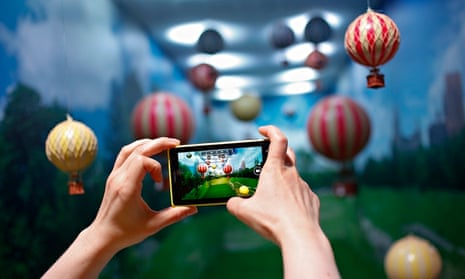Remember the Walkman? How it allowed you to take your music wherever you went. The e-reader has done the same thing to your library and the tablet device to your TV and your DVD collection. Last week, Shakespeare’s Globe launched Globe Player, a service that allows users to stream and/or download its productions onto their computers and mobile devices. Online audiences can watch 51 of the theatre’s past productions wherever (and whenever) they happen to be. The Google Cultural Institute has also made huge swathes of visual art and museum exhibits just as accessible.
Mobile technology has changed the way we encounter art. It has made art mobile. “On demand” has extended into “on the go”. Art is everywhere – and everyone with a smartphone is a potential audience member.

As Ruth Mackenzie, interim CEO and creative director of The Space, a new BBC and Arts Council England-backed digital arts platform, puts it: “The average person looks at their mobile 100 times a day, so just imagine if art were a part of that diet. What if, instead of playing Candy Crush, you did art?” That picture’s too simple; it implies the only shift is in the interface – the mode of encounter as opposed to the encounter itself. Screens have replaced the page and the stage, but it’s deeper than that; digital art is a form of its own, with its own rules and possibilities.
One possibility is that offered by The Space, which is running an open call for new digital art designed for mobile tech and tablet computers. Any artist over 18-years-old, from anywhere in the world can apply. “If film was the new discovery and the dominant artform of the 20th century, then maybe digital art is going to be of the 21st,” says Mackenzie. “That’s the opportunity we’ve got.”
Become the art
We’re already so accustomed to mobile technology that experiencing art through it feels as natural as any other interface. It can be hard to see just how categorically it changes (and could yet change) art. Think wearable tech: Google Glass, for instance, or Oculus Rift, both of which extend the possibilities even further to virtual or augmented realities and audiences existing within artworks, not simply looking on.
But first, let’s go back. I first found mobile technology being used in art in 2008 through Blast Theory’s Rider Spoke. Audiences had to cycle through London, hooked up to a smartphone, “hiding” voice recordings – secrets, confessions, memories – on wireless networks around the city for others to find. It was a thrilling experience and, six years on, still shapes my relationship with that part of London.
“The key driver in all these technologies is a rise in interaction and participation,” says Blast Theory’s Matt Adams. Rather than audiences, the company talks about participants. “It reflects the sheer breadth of the way people might engage with the work we’re making.”
That’s largely down to the nature of the device itself. “The mobile phone is a very private and intimate technology,” says Adams. Using it as a cultural platform, therefore, changes the artist’s relationship with the participant. One Blast Theory piece, Day of the Figurines, was a game played via SMS over 24 days. “[Art] becomes interwoven with every aspect of your life … it allows us to permeate into your life in a way that we couldn’t otherwise manage.”
Meet Karen
Mobile technology is a two-way encounter. It can tell the artists about the participant – and vice versa. Blast Theory’s next project, an app called Karen, relies on that.
Karen is a virtual life-coach in the form of an app. “Initially, she claims to be able to offer advice, but gradually she gets more interested and the boundary between her professional life and her personal life starts to break down a bit,” says Adams. Crucially, Karen adapts to the information you provide.
But Karen isn’t a computer game. There’s no winning and losing. It’s narrative-driven, but it’s not really television or film; it’s a hybrid form. Technology is shifting the territory of art. The more we see the screen – whatever its size or shape – as an artistic interface, like the stage or the cinema, the more we can see anything on it as art.
For Adams, it’s in “the world of games, particularly indie games, that the most exciting and risk-taking work is taking place”. Artists are starting to pick at the seams of the form. Take Papa Sangre, a game for handheld devices created by content business Somethin’ Else. Described as a “video game with no video,” it presents players with a black screen to represent a pitch-black labyrinth, which players navigate using the surround-soundtrack they hear through headphones. Sidestep the mythic-quest casing and you’ve got a smart little artwork exploring sensory deprivation, but one that could only exist on a mobile device.
With the right selection of apps, every smartphone owner has a digital camera or a set of mixing decks to hand; every tablet user can cut together a film and upload it straight onto YouTube. These devices make every user a potential artist in a more spontaneous way than ever before. “There’s access to the means of creating art that simply wasn’t there 20 years ago,” says Mackenzie. “You can talk about finding new audiences, but I think we’re going to find new artists too.”
More like this
Has technology changed cultural taste?
Post-web technology: what comes next for museums?
Musical shoes and dancing drones: the arts meet technology in Japan
Join our community of arts, culture and creative professionals by signing up free to the Guardian Culture Pros Network.

Comments (…)
Sign in or create your Guardian account to join the discussion